Grand Chancellor of Lithuania
 From Wikipedia - Reading time: 7 min
From Wikipedia - Reading time: 7 min
| Grand Chancellor of Lithuania | |
|---|---|
 | |
| Appointer | Grand Duke of Lithuania |
| Precursor | Chancellor of Lithuania |
| Formation | 15th century |
| First holder | Sudivojus Valimantaitis |
| Final holder | Joachim Chreptowicz |
| Abolished | 1795 |
The Grand Chancellor of Lithuania (Lithuanian: Lietuvos didysis kancleris) was one of the highest offices in the Grand Duchy of Lithuania. The office functioned from the middle of the 15th century until the end of the real union with the Kingdom of Poland in 1795 and its subsequent partition among Prussia, Russia and Austria.[1] The chancellor possessed the Great Seal of Lithuania and had the Lithuanian Metrica at his disposal.[2]
History
[edit]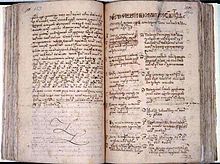
It is thought that the role of chancellor originated from court positions of the manor of the Grand Duke of Lithuania. Although the role of a state chancellor existed since the times of Grand Duke Vytautas, it formally appeared during the reign of Casimir IV Jagiellon.[1] The expanding territory of the Grand Duchy of Lithuania and the increasing value of land, property as well as judicial institutions meant an increased need for written documents. The needs of Vytautas's political diplomacy with the Grand Duchy of Moscow, Byzantine Empire and tatars were met with the creation of two chancelleries - the first of which would prepare documents in Latin and German, while the second would prepare documents in Russian. Eleven scribes worked in those offices, some of whom were sent by Vytautas's cousin and king of Poland, Jogaila, from his estate in Poland (Mikalojus Cebulka and Mikalojus Maldrzykas are examples of such scribes). It is known that three scribes came from the Teutonic Order. Scribes from Volhynia were given the task of assisting in writing Ruthenian, although it is believed that some Ruthenian documents were prepared by Lithuanians.[3] Up until the Union of Lublin the role of the Grand Chancellor would be the second highest next to the Grand Duke since he would usually reside in Poland and consequently Grand Chancellor oversaw most of the Grand Duchy's politics as well as the Lithuanian Council of Lords.[1]
Since official roles weren't yet formalized, the scribe's office would be categorized as either a simple scribe or the secretary of the Grand Duke. During the reign of Casimir IV Jagiellon, the chancellery would be fully established. Its first grand chancellor was Sudivojus Valimantaitis. During the reign of Alexander Jagiellon, the chancellery became the center of the politics of the Grand Duchy. Offices became categorized into treasury-related matters and diplomacy-related matters. The Grand Chancellor would usually be a member of a noble magnate family, such as the Radziwill, Sapieha, Gasztowt families. Up until the creation of the Lithunaian Tribunal in 1581, the Grand Chancellor led the Grand Duchy's Supreme Court. In the 16th century, the number of scribes as well as literacy itself increased; tariffs and taxes would be more frequently and effectively checked within the country's territory. The Grand Chancellor would usually have a second role of being the Voivode of Vilnius as well as the Castellan of Vilnius,[3] although this practice would later be abandoned. Until the creation of the Permanent Council, the Grand Chancellor would oversee relations with the Russian Empire.[1]
Today the office of the chancellor has been replaced by that of the Prime Minister of Lithuania.
List of Grand Chancellors
[edit]| Portrait | Name | Birth | Term | Death |
|---|---|---|---|---|
| Sudivojus Valimantaitis | 1441–1444 | |||
| Mykolas Kęsgaila | 1444–1476 | 1476 | ||
| Alekna Sudimantaitis | 1478–1490 | 1490 | ||

|
Mikalojus Radvila | 1450 | 1492–1509 | 16 July 1509 |

|
Mikołaj II Radziwiłł | 1470 | 1510–1529 | 1529 |

|
Albertas Goštautas | 1480 | 1522–1539 | 1539 |
| Jonas Glebavičius | 1546–1549 | |||

|
Mikołaj "the Black" Radziwiłł | 4 February 1515 | 1550–1565 | 28 May 1565 |

|
Mikołaj Radziwiłł VI | 1512 | 1565–1584 | 27 April 1584 |

|
Lew Sapieha | 4 April 1557 | 1589–1623 | 7 July 1633 |
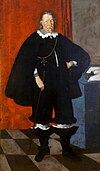
|
Albrycht Stanisław Radziwiłł | 1 July 1595 | 1623–1656 | 12 November 1656 |
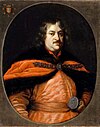
|
Krzysztof Zygmunt Pac | 1621 | 1658–1684 | 1684 |

|
Marcjan Aleksander Ogiński | 1632 | 1684–1690 | 5 January 1690 |
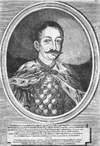
|
Dominik Mikołaj Radziwiłł | 1643 | 1690–1697 | 1697 |
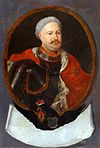
|
Karol Radziwiłł | 1668 | 1698–1719 | 1719 |

|
Michał Serwacy Wiśniowiecki | 13 May 1680 | 1720–1735 | 18 September 1744 |

|
Jan Fryderyk Sapieha | 1680 | 1635–1651 | 1651 |

|
Michał Fryderyk Czartoryski | 1696 | 1752–1755 | 1775 |
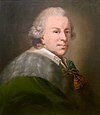
|
Aleksander Michał Sapieha | 1730 | 1755–1793 | 1793 |

|
Joachim Chreptowicz | 4 January 1729 | 1793–1795 | 4 March 1812 |
- Source supporting the list.[1]
See also
[edit]References
[edit]- ^ a b c d e Gudavičius, Edvardas; Spečiūnas, Vytautas. "kancleris". vle.lt.
- ^ Ragauskienė, Raimonda. "LDK istorija: kaip LDK kancleriai XVI a. saugojo Lietuvos Metriką". 15min.lt (in Lithuanian). Retrieved 28 December 2023.
- ^ a b Cicėnienė, Rima (2009). RANKRAŠTINĖ KNYGA LIETUVOS DIDŽIOJOJE KUNIGAIKŠTYSTĖJE XIV a. PRADŽIOJE– XVI a. VIDURYJE: SKLAIDOS IR FUNKCIONAVIMO SĄLYGOS. pp. 24–25.
 KSF
KSF